How Reliable Are the Spectral Vegetation Indices for the Assessment of Tree Condition and Mortality in European Temporal Forests?
Abstract
1. Introduction
2. Materials and Methods
2.1. Study Area
2.2. NDVI and EVI Monthly Values
2.3. Volume of Dead Trees in the Forest Stands
2.4. Methods
3. Results
3.1. Trends in Changes in NDVI and EVI Z-Scores
3.2. Temporal Variations in the Volume of Dead Trees
3.3. Coupling the Trends in NDVI and EVI Z-Scores with the Course of Dead Trees
4. Discussion
5. Conclusions
Author Contributions
Funding
Data Availability Statement
Conflicts of Interest
References
- FAO; UNEP. The State of the World’s Forests 2020. In Forests, Biodiversity and People; FAO and UNEP: Rome, Italy, 2020. [Google Scholar] [CrossRef]
- Pan, Y.; Birdsey, R.A.; Phillips, O.L.; Jackson, R.B. The Structure, Distribution, and Biomass of the World’s Forests. Annu. Rev. Ecol. Evol. Syst. 2013, 44, 593–622. [Google Scholar] [CrossRef]
- de Rigo, D.; Bosco, C.; San-Miguel-Ayanz, J.; Houston Durrant, T.; Barredo, J.I.; Strona, G.; Caudullo, G.; Di Leo, M.; Boca, R. Forest resources in Europe: An overview on ecosystem services, disturbances and threats. In European Atlas of Forest Tree Species; San-Miguel-Ayanz, J., de Rigo, D., Caudullo, G., Houston Durrant, T., Mauri, A., Eds.; Publications Office of the EU: Luxembourg, 2016; p. e015b050. [Google Scholar]
- Adole, T.; Dash, J.; Atkinson, P.M. A systematic review of vegetation phenology in Africa. Ecol. Inform. 2016, 34, 117–128. [Google Scholar] [CrossRef]
- Buras, A.; Rammig, A.; Zang, C.S. Quantifying impacts of the 2018 drought on European ecosystems in comparison to 2003. Biogeosciences 2020, 17, 1655–1672. [Google Scholar] [CrossRef]
- Huang, S.; Tang, L.; Hupy, J.P.; Wang, Y.; Shao, G. A commentary review on the use of Normalized Difference Vegetation Index (NDVI) in the era of popular remote sensing. J. For. Res. 2021, 32, 1–6. [Google Scholar] [CrossRef]
- Soubry, I.; Doan, T.; Chu, T.; Guo, X. A Systematic Review on the Integration of Remote Sensing and GIS to Forest and Grassland Ecosystem Health Attributes, Indicators, and Measures. Remote Sens. 2021, 13, 3262. [Google Scholar] [CrossRef]
- Didan, K.; Munoz, A.B. MODIS Vegetation Index User’s Guide (MOD13 Series); Vegetation Index and Phenology Lab, The University of Arizona: Tucson, AZ, USA, 2019. [Google Scholar]
- Gao, X.; Huete, A.R.; Ni, W.; Miura, T. Optical–Biophysical Relationships of Vegetation Spectra without Background Contamination. Remote Sens. Environ. 2000, 74, 609–620. [Google Scholar] [CrossRef]
- Van Der Meer, F.; Bakker, W.; Scholte, K.; Skidmore, A.; De Jong, S.; Clevers, J.; Addink, E.; Epema, G. Spatial scale variations in vegetation indices and above-ground biomass estimates: Implications for MERIS. Int. J. Remote Sens. 2001, 22, 3381–3396. [Google Scholar] [CrossRef]
- Huete, A.; Didan, K.; Miura, T.; Rodriguez, E.P.; Gao, X.; Ferreira, L.G. Overview of the radiometric and biophysical performance of the MODIS vegetation indices. Remote Sens. Environ. 2002, 83, 195–213. [Google Scholar] [CrossRef]
- Kulesza, K.; Hościło, A. Influence of climatic conditions on Normalized Difference Vegetation Index variability in forest in Poland (2002–2021). Meteorol. Appl. 2023, 30, e2156. [Google Scholar] [CrossRef]
- Barka, I.; Bucha, T.; Molnár, T.; Móricz, N.; Somogyi, Z.; Koreň, M. Suitability of MODIS-based NDVI index for forest monitoring and its seasonal applications in Central Europe. Cent. Eur. For. J. 2019, 65, 206–217. [Google Scholar] [CrossRef]
- Prăvălie, R.; Sîrodoev, I.; Nita, I.-A.; Patriche, C.; Dumitraşcu, M.; Roşca, B.; Tişcovschi, A.; Bandoc, G.; Săvulescu, I.; Mănoiu, V.; et al. NDVI-based ecological dynamics of forest vegetation and its relationship to climate change in Romania during 1987–2018. Ecol. Indic. 2022, 136, 108629. [Google Scholar] [CrossRef]
- Yang, Y.; Wang, S.; Bai, X.; Tan, Q.; Li, Q.; Wu, L.; Tian, S.; Hu, Z.; Li, C.; Deng, Y. Factors Affecting Long-Term Trends in Global NDVI. Forests 2019, 10, 372. [Google Scholar] [CrossRef]
- Gazol, A.; Camarero, J.J.; Vicente-Serrano, S.M.; Sánchez-Salguero, R.; Gutiérrez, E.; de Luis, M.; Sangüesa-Barreda, G.; Novak, K.; Rozas, V.; Tíscar, P.A.; et al. Forest resilience to drought varies across biomes. Glob. Change Biol. 2018, 24, 2143–2158. [Google Scholar] [CrossRef] [PubMed]
- Araghi, A.; Martinez, C.J.; Adamowski, J.; Olesen, J.E. Associations between large-scale climate oscillations and land surface phenology in Iran. Agric. For. Meteorol. 2019, 278, 107682. [Google Scholar] [CrossRef]
- Farbo, A.; Sarvia, F.; De Petris, S.; Basile, V.; Borgogno-Mondino, E. Forecasting corn NDVI through AI-based approaches using sentinel 2 image time series. ISPRS J. Photogramm. Remote Sens. 2024, 211, 244–261. [Google Scholar] [CrossRef]
- Moreira, A.; Fontana, D.C.; Kuplich, T.M. Wavelet approach applied to EVI/MODIS time series and meteorological data. ISPRS J. Photogramm. Remote Sens. 2019, 147, 335–344. [Google Scholar] [CrossRef]
- Tang, W.X.; Liu, S.G.; Kang, P.; Peng, X.; Li, Y.Y.; Guo, R.; Jia, J.N.; Liu, M.C.; Zhu, L.J. Quantifying the lagged effects of climate factors on vegetation growth in 32 major cities of China. Ecol. Indic. 2021, 132, 108290. [Google Scholar] [CrossRef]
- Galvao, L.S.; dos Santos, J.R.; Roberts, D.A.; Breunig, F.M.; Toomey, M.; de Moura, Y.M. On intra-annual EVI variability in the dry season of tropical forest: A case study with MODIS and hyperspectral data. Remote Sens. Environ. 2011, 115, 2350–2359. [Google Scholar] [CrossRef]
- Lara, C.; Saldías, G.S.; Cazelles, B.; Rivadeneira, M.M.; Muñoz, R.; Galán, A.; Paredes, A.L.; Fierro, P.; Broitman, B.R. Climatic Regulation of Vegetation Phenology in Protected Areas along Western South America. Remote Sens. 2021, 13, 2590. [Google Scholar] [CrossRef]
- Zhang, Y.; Song, C.; Band, L.E.; Sun, G.; Li, J. Reanalysis of global terrestrial vegetation trends from MODIS products: Browning or greening? Remote Sens. Environ. 2017, 191, 145–155. [Google Scholar] [CrossRef]
- Li, Z.; Li, X.; Wei, D.; Xu, X.; Wang, H. An assessment of correlation on MODIS-NDVI and EVI with natural vegetation coverage in Northern Hebei Province, China. Procedia Environ. Sci. 2010, 2, 964–969. [Google Scholar] [CrossRef]
- Miura, T.; Smith, C.Z.; Yoshioka, H. Validation and analysis of Terra and Aqua MODIS, and SNPP VIIRS vegetation indices under zero vegetation conditions: A case study using Railroad Valley Playa. Remote Sens. Environ. 2021, 257, 112344. [Google Scholar] [CrossRef]
- Khare, S.; Deslauriers, A.; Morin, H.; Latifi, H.; Rossi, S. Comparing Time-Lapse PhenoCams with Satellite Observations across the Boreal Forest of Quebec, Canada. Remote Sens. 2022, 14, 100. [Google Scholar] [CrossRef]
- Crespo-Antia, J.P.; Gazol, A.; Pizarro, M.; de Andrés, E.G.; Valeriano, C.; Cuadrado, A.R.; Linares, J.C.; Camarero, J.J. Matching Vegetation Indices and Tree Vigor in Pyrenean Silver Fir Stands. Remote Sens. 2024, 16, 4564. [Google Scholar] [CrossRef]
- Aubard, V.; Paulo, J.A.; Silva, J.M.N. Long-Term Monitoring of Cork and Holm Oak Stands Productivity in Portugal with Landsat Imagery. Remote Sens. 2019, 11, 525. [Google Scholar] [CrossRef]
- Sinan, M.; Hasenauer, H. How to determine the leaf area index (LAI) of forests: A comparison of forest inventory versus satellite-driven estimates. For. Ecosyst. 2025, 13, 100332. [Google Scholar] [CrossRef]
- Čuchta, P. Natural disturbances (with a special reference to windthrow): A literature review. In Advances in Environmental Research; Nova: New York, NY, USA, 2020; Volume 72, pp. 153–172. [Google Scholar]
- Đuka, A.; Franjević, M.; Tomljanović, K.; Popović, M.; Ugarković, D.; Teslak, K.; Barčić, D.; Žagar, K.; Palatinuš, K.; Papa, I. A Decade of Sanitary Fellings Followed by Climate Extremes in Croatian Managed Forests. Land 2025, 14, 766. [Google Scholar] [CrossRef]
- Lech, P.; Kamińska, A. “Mortality, or not mortality, that is the question …”: How to Treat Removals in Tree Survival Analysis of Central European Managed Forests. Plants 2024, 13, 248. [Google Scholar] [CrossRef] [PubMed]
- Shvidenko, A.; Mukhortova, L.; Kapitsa, E.; Kraxner, F.; See, L.; Pyzhev, A.; Gordeev, R.; Fedorov, S.; Korotkov, V.; Bartalev, S.; et al. A Modelling System for Dead Wood Assessment in the Forests of Northern Eurasia. Forests 2023, 14, 45. [Google Scholar] [CrossRef]
- Socha, J.; Hawryło, P.; Tymińska-Czabańska, L.; Reineking, B.; Lindner, M.; Netzel, P.; Grabska-Szwagrzyk, E.; Vallejos, R.; Reyer, C.P.O. Higher site productivity and stand age enhance forest susceptibility to drought-induced mortality. Agric. For. Meteorol. 2023, 341, 109680. [Google Scholar] [CrossRef]
- Tymińska-Czabańska, L.; Hawryło, P.; Janiec, P.; Socha, J. Tree height, growth rate and stand density determined by ALS drive probability of Scots pine mortality. Ecol. Indic. 2022, 145, 109643. [Google Scholar] [CrossRef]
- Tomczyk, A.M.; Bednorz, E. Atlas Klimatu Polski (1991–2020); Bogucki Wydawnictwo Naukowe: Poznan, Poland, 2022. [Google Scholar]
- Zajączkowski, G.; Jabłołski, M.; Jabłołski, T.; Sikora, K.; Kowalska, A.; Małachowska, J.; Piwnicki, J. (Eds.) Raport o Stanie Lasów w Polsce 2021; Centrum Informacyjne Lasów Państwowych: Warsaw, Poland, 2022. [Google Scholar]
- RDLP Lublin. Lasy Regionu. Available online: https://www.lublin.lasy.gov.pl/lasy-regionu (accessed on 14 December 2023).
- Zięba, M. Lasy Regionu. Available online: https://www.wroclaw.lasy.gov.pl/lasy-regionu (accessed on 14 December 2023).
- Hościło, A.; Lewandowska, A. Mapping Forest Type and Tree Species on a Regional Scale Using Multi-Temporal Sentinel-2 Data. Remote Sens. 2019, 11, 929. [Google Scholar] [CrossRef]
- Hościło, A.; Kulesza, K.; Lewandowska, A. Application of Sentinel-2 Data for Mapping Tree Species and Detecting Forest Decline. In Proceedings of the CLMS General Assembly 2025, Cracow, Poland, 20–22 May 2025; Available online: https://clms-general-assembly-global-network-users.mailerpage.io/posters-2025 (accessed on 15 June 2025).
- Didan, K. MODIS/Aqua Vegetation Indices 16-Day L3 Global 250m SIN Grid V061 [Data Set]; NASA EOSDIS Land Processes DAAC: Pasadena, CA, USA, 2021. [Google Scholar] [CrossRef]
- Didan, K. MODIS/Terra Vegetation Indices 16-Day L3 Global 250m SIN Grid V061 [Data Set]; NASA EOSDIS Land Processes DAAC: Pasadena, CA, USA, 2021. [Google Scholar] [CrossRef]
- Holben, B.N. Characteristics of maximum-value composite images from temporal AVHRR data. Int. J. Remote Sens. 1986, 7, 1417–1434. [Google Scholar] [CrossRef]
- Kulesza, K.; Hościło, A. Temporal Patterns of Vegetation Greenness for the Main Forest-Forming Tree Species in the European Temperate Zone. Remote Sens. 2024, 16, 2844. [Google Scholar] [CrossRef]
- FDB Polish Forest Data Bank. Polish State Forests State Holding; 2024. Available online: https://www.bdl.lasy.gov.pl/portal/en (accessed on 14 December 2024).
- Liu, Y.; Li, Y.; Li, S.; Motesharrei, S. Spatial and Temporal Patterns of Global NDVI Trends: Correlations with Climate and Human Factors. Remote Sens. 2015, 7, 13233–13250. [Google Scholar] [CrossRef]
- Piao, S.; Wang, X.; Ciais, P.; Zhu, B.; Wang, T.; Liu, J. Changes in satellite-derived vegetation growth trend in temperate and boreal Eurasia from 1982 to 2006. Glob. Change Biol. 2011, 17, 3228–3239. [Google Scholar] [CrossRef]
- Ionita, M.; Tallaksen, L.M.; Kingston, D.G.; Stagge, J.H.; Laaha, G.; Van Lanen, H.A.J.; Scholz, P.; Chelcea, S.M.; Haslinger, K. The European 2015 drought from a climatological perspective. Hydrol. Earth Syst. Sci. 2017, 21, 1397–1419. [Google Scholar] [CrossRef]
- Boergens, E.; Güntner, A.; Dobslaw, H.; Dahle, C. Quantifying the Central European Droughts in 2018 and 2019 With GRACE Follow-On. Geophys. Res. Lett. 2020, 47, e2020GL087285. [Google Scholar] [CrossRef]
- Hari, V.; Rakovec, O.; Markonis, Y.; Hanel, M.; Kumar, R. Increased future occurrences of the exceptional 2018–2019 Central European drought under global warming. Sci. Rep. 2020, 10, 12207. [Google Scholar] [CrossRef] [PubMed]
- Somorowska, U. Amplified signals of soil moisture and evaporative stresses across Poland in the twenty-first century. Sci. Total Environ. 2022, 812, 151465. [Google Scholar] [CrossRef] [PubMed]
- Schuldt, B.; Buras, A.; Arend, M.; Vitasse, Y.; Beierkuhnlein, C.; Damm, A.; Gharun, M.; Grams, T.E.E.; Hauck, M.; Hajek, P.; et al. A first assessment of the impact of the extreme 2018 summer drought on Central European forests. Basic Appl. Ecol. 2020, 45, 86–103. [Google Scholar] [CrossRef]
- Brun, P.; Psomas, A.; Ginzler, C.; Thuiller, W.; Zappa, M.; Zimmermann, N.E. Large-scale early-wilting response of Central European forests to the 2018 extreme drought. Glob. Change Biol. 2020, 26, 7021–7035. [Google Scholar] [CrossRef] [PubMed]
- Carl, G.; Doktor, D.; Koslowsky, D.; Kühn, I. Phase difference analysis of temperature and vegetation phenology for beech forest: A wavelet approach. Stoch. Environ. Res. Risk Assess. 2013, 27, 1221–1230. [Google Scholar] [CrossRef]
- Kulesza, K.; Hościło, A. Coherency and time lag analyses between MODIS vegetation indices and climate across forests and grasslands in the European temperate zone. Biogeosciences 2024, 21, 2509–2527. [Google Scholar] [CrossRef]
- Dossa, G.G.O.; Paudel, E.; Schaefer, D.; Zhang, J.L.; Cao, K.F.; Xu, J.C.; Harrison, R.D. Quantifying the factors affecting wood decomposition across a tropical forest disturbance gradient. For. Ecol. Manag. 2020, 468, 118166. [Google Scholar] [CrossRef]
- Burton, J.E.; Bennett, L.T.; Kasel, S.; Nitschke, C.R.; Tanase, M.A.; Fairman, T.A.; Parker, L.; Fedrigo, M.; Aponte, C. Fire, drought and productivity as drivers of dead wood biomass in eucalypt forests of south-eastern Australia. For. Ecol. Manag. 2021, 482, 118859. [Google Scholar] [CrossRef]
- Vlad, R.; Sidor, C.G.; Dinca, L.; Constandache, C.; Grigoroaea, D.A.N.; Ispravnic, A.; Pei, G. Dead wood diversity in a Norway spruce forest from the cãlimani national park (The eastern carpathians). Balt. For. 2019, 25, 238–248. [Google Scholar] [CrossRef]
- Käfer, P.S.; Rex, F.E.; Breunig, F.M.; Balbinot, R. Modeling pinus elliottii growth with multitemporal landsat data: A study case in southern Brazil. Bol. Cienc. Geod. 2018, 24, 286–299. [Google Scholar] [CrossRef]
- Roy, B. Optimum machine learning algorithm selection for forecasting vegetation indices: MODIS NDVI & EVI. Remote Sens. Appl. Soc. Environ. 2021, 23, 100582. [Google Scholar] [CrossRef]
- Chen, R.; Yin, G.; Liu, G.; Li, J.; Verger, A. Evaluation and normalization of topographic effects on vegetation indices. Remote Sens. 2020, 12, 2290. [Google Scholar] [CrossRef]
- Yan, Y.; Piao, S.; Hammond, W.M.; Chen, A.; Hong, S.; Xu, H.; Munson, S.M.; Myneni, R.B.; Allen, C.D. Climate-induced tree-mortality pulses are obscured by broad-scale and long-term greening. Nat. Ecol. Evol. 2024, 8, 912–923. [Google Scholar] [CrossRef] [PubMed]
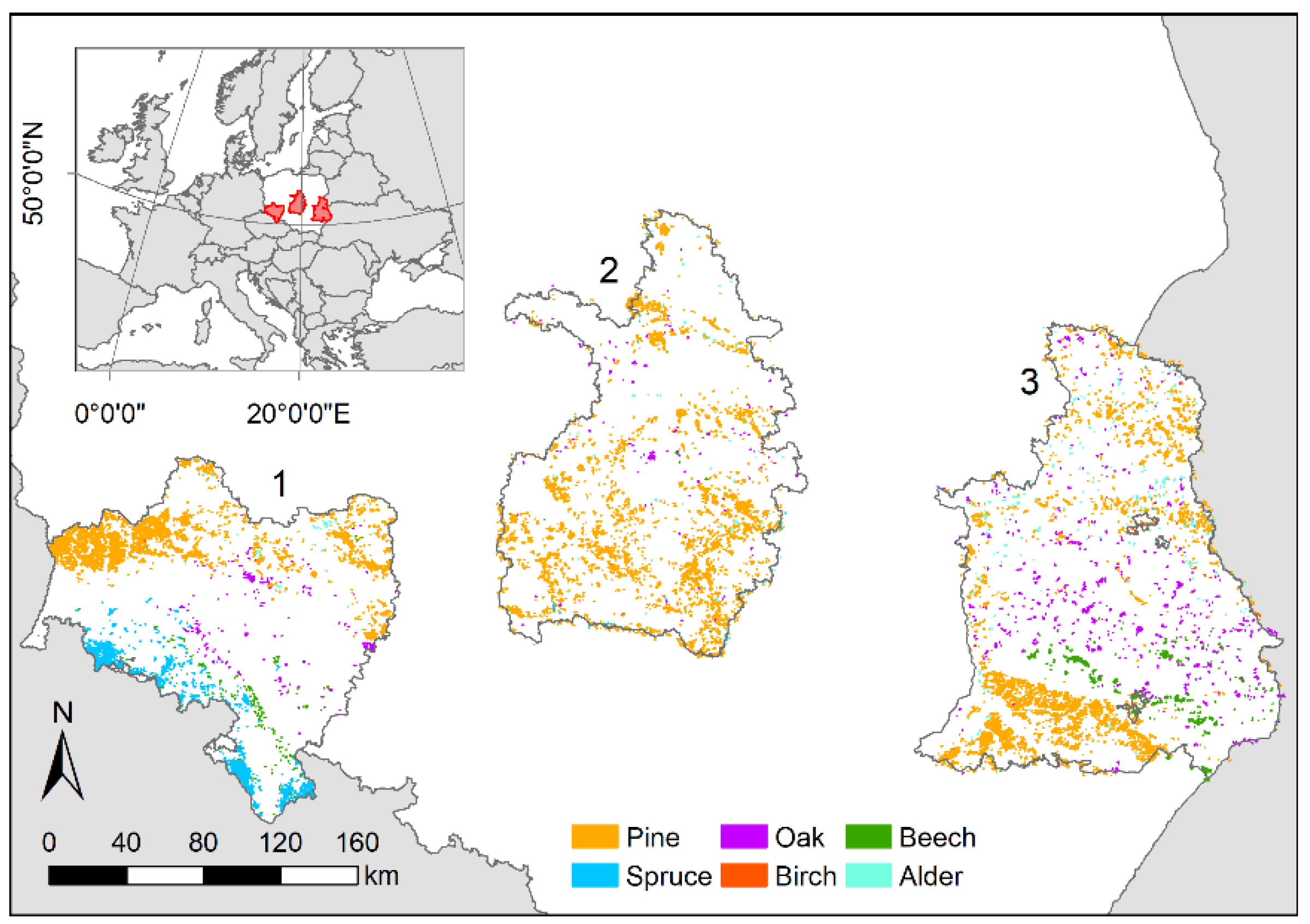

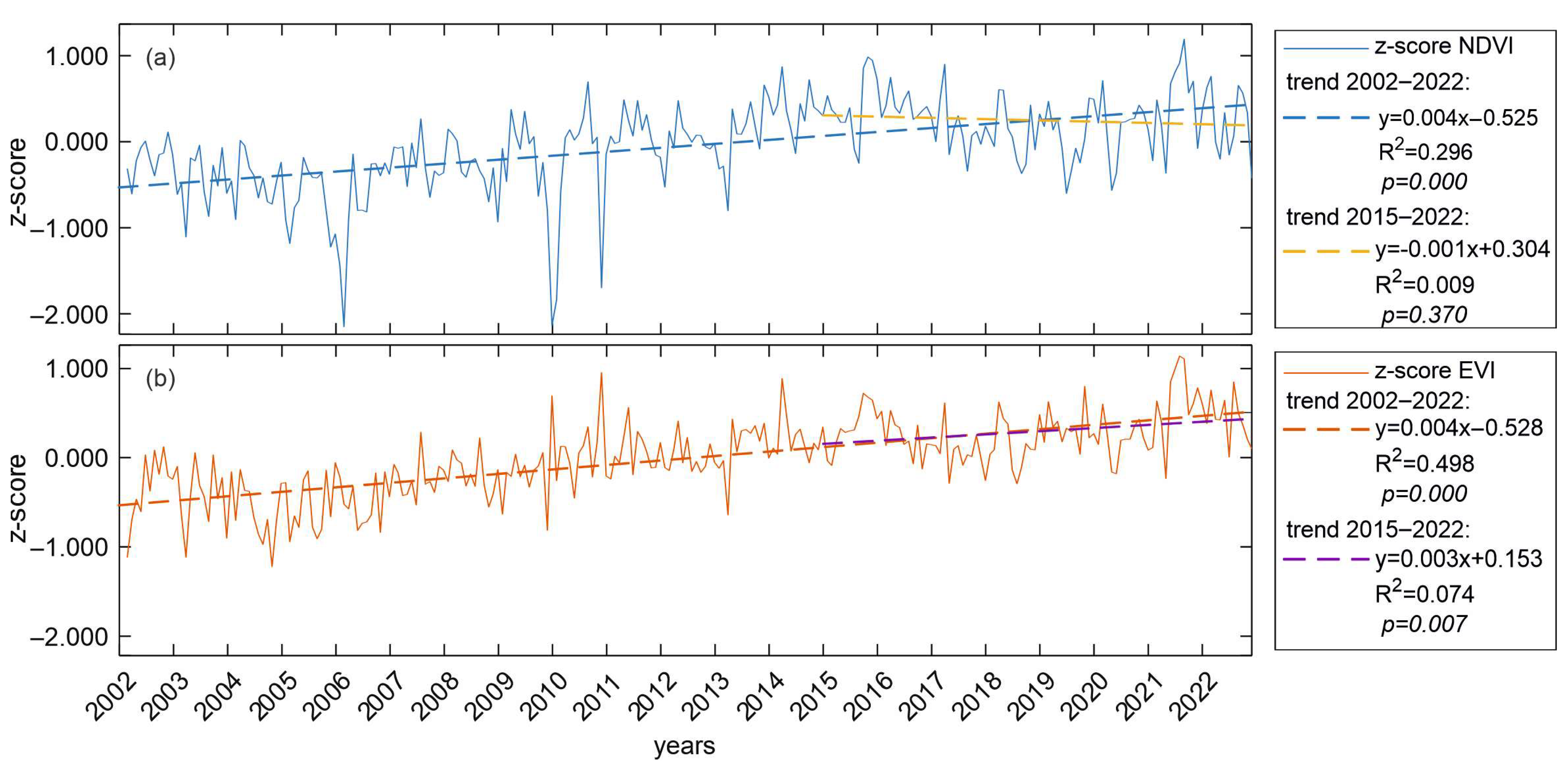
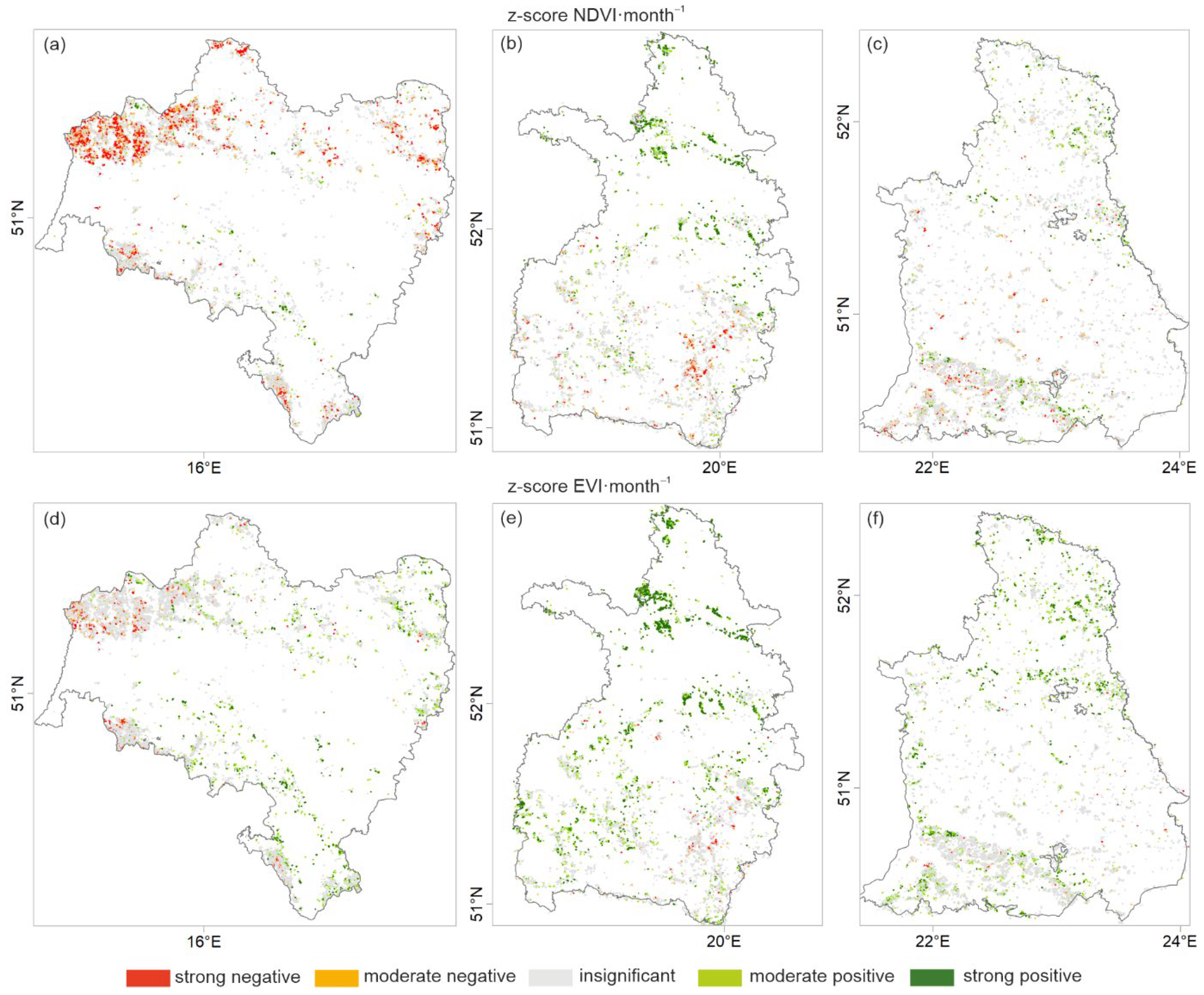

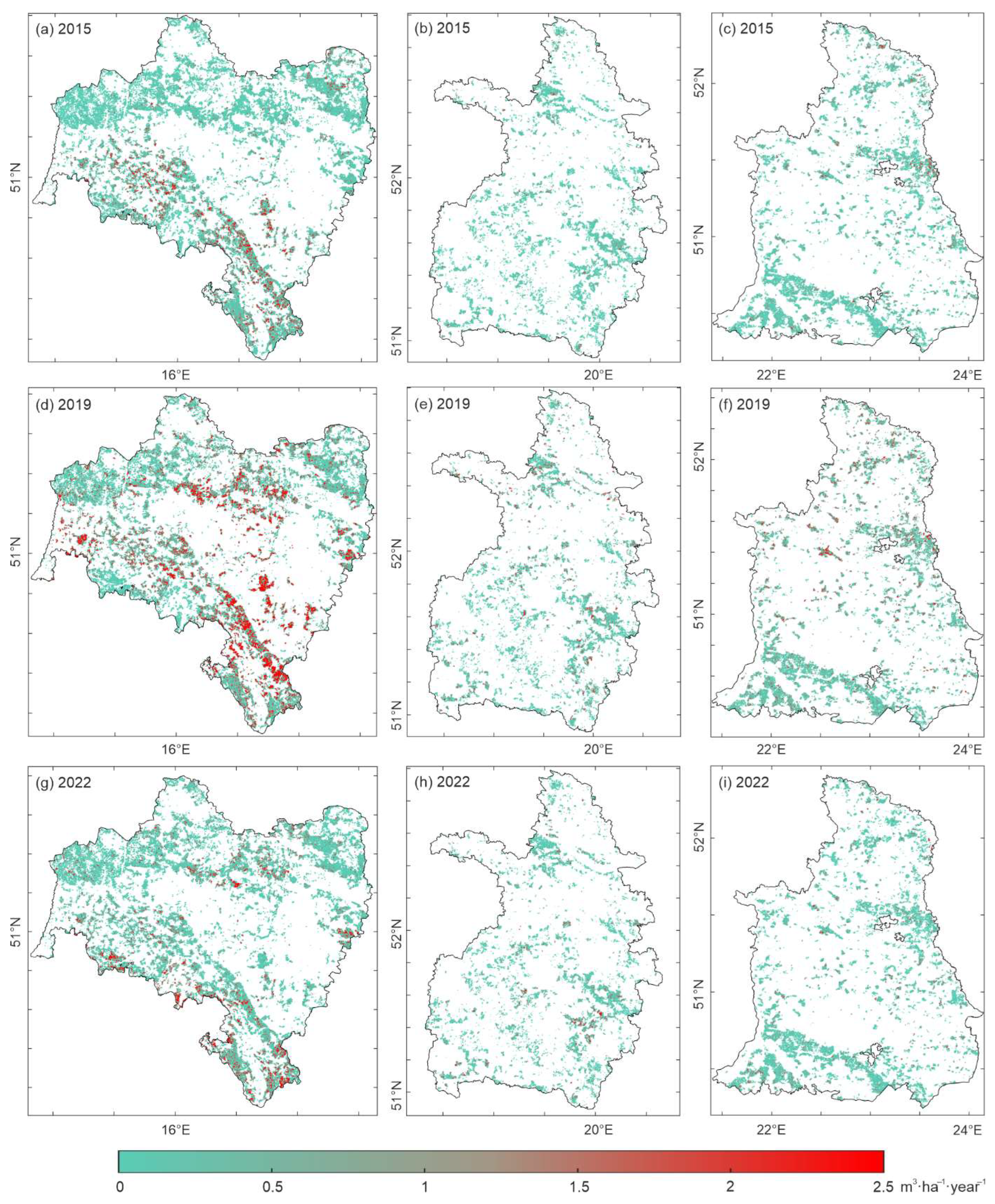
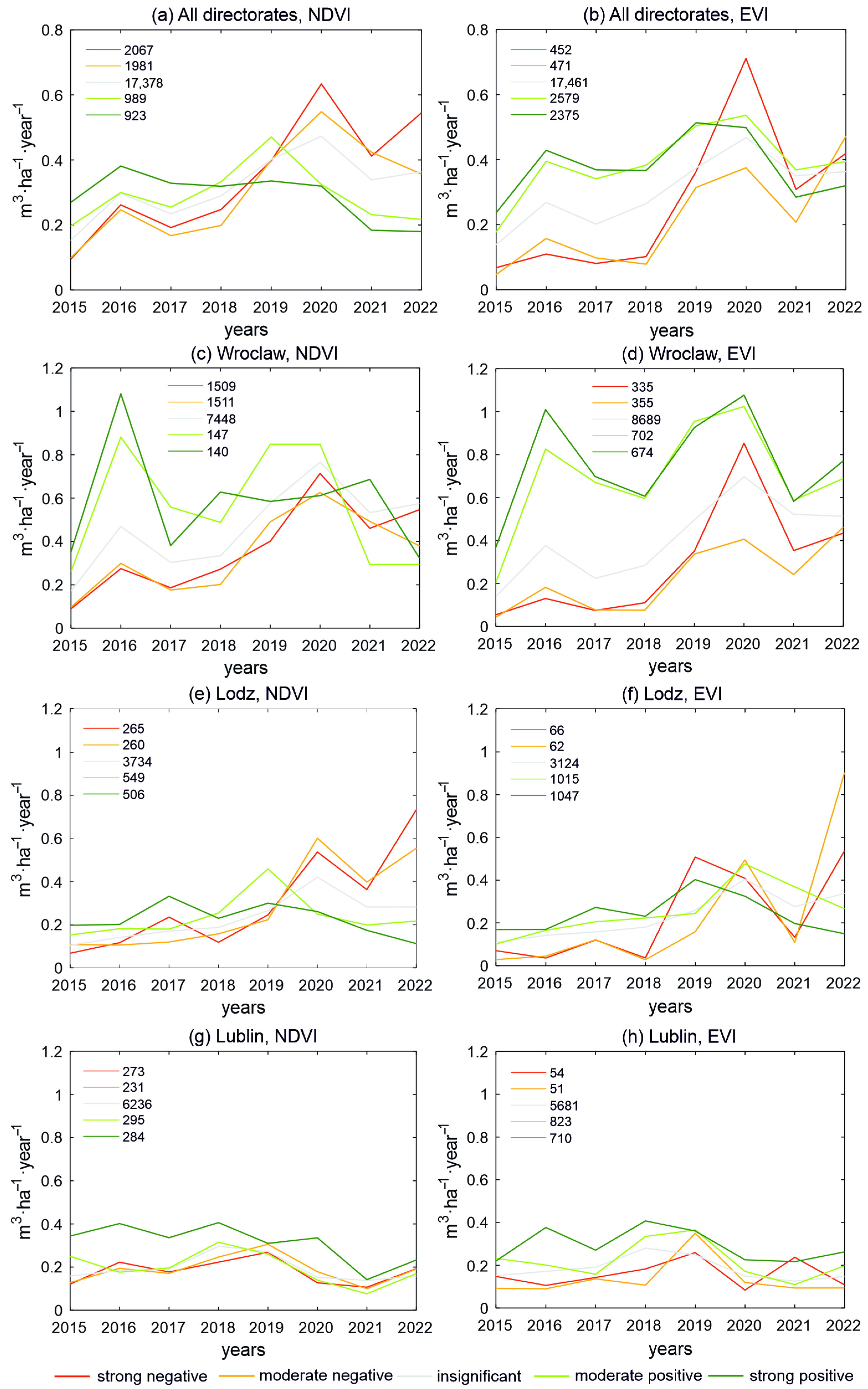
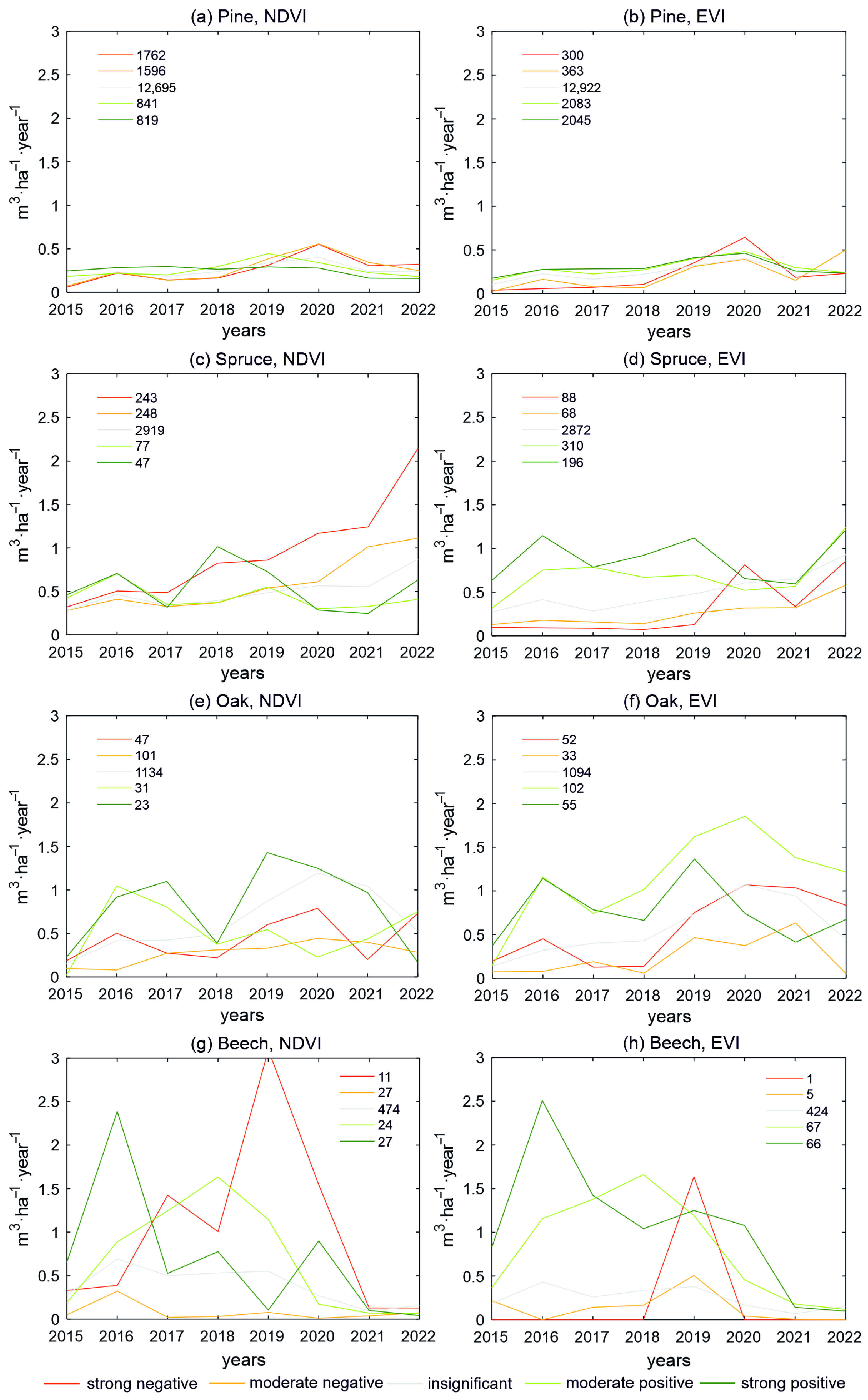
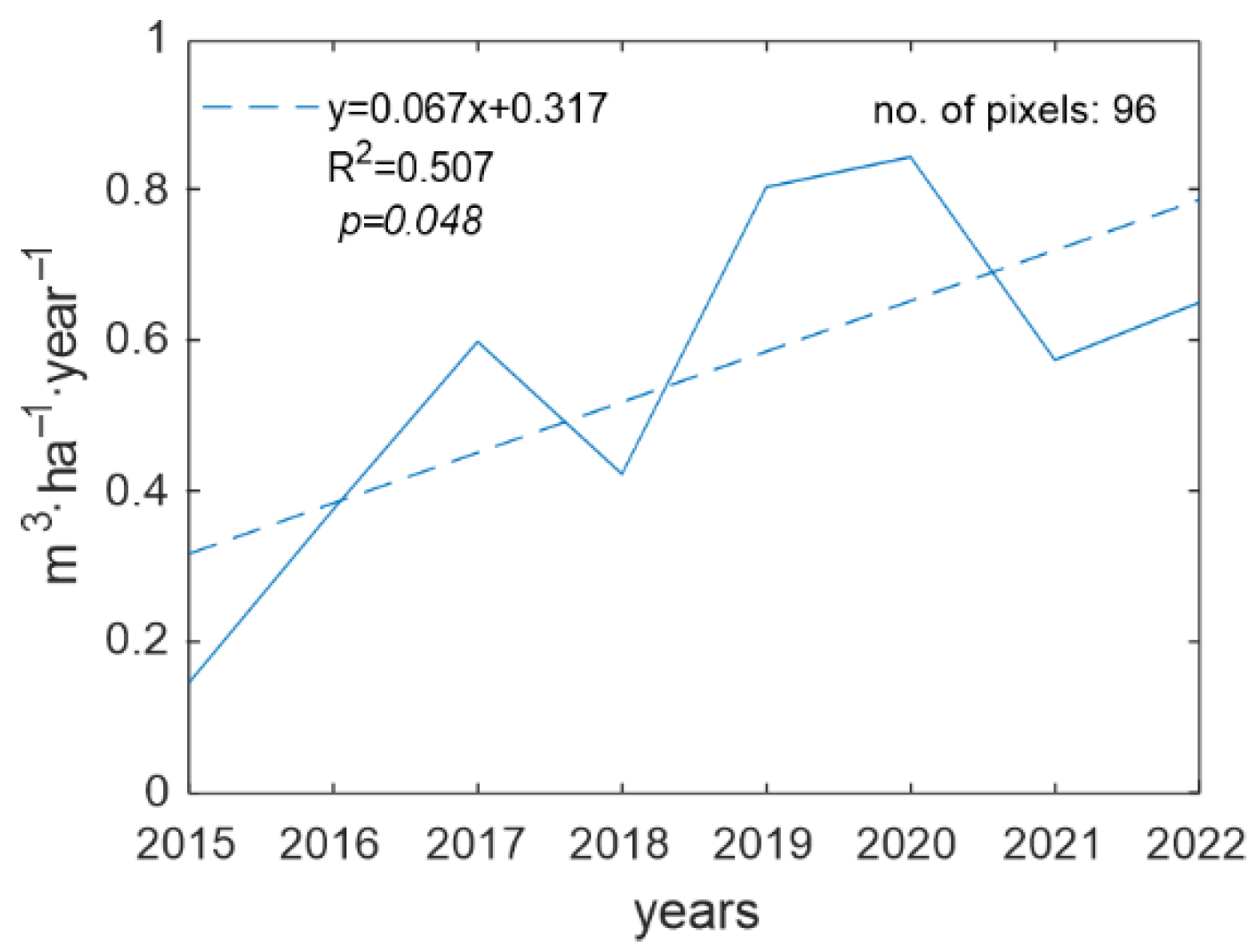
| Species Mask | Number of MODIS Pixels | Area (km2) | Used Further in This Study | |||
|---|---|---|---|---|---|---|
| Wroclaw | Lodz | Lublin | Total | |||
| Pine | 8698 | 9683 | 10,234 | 28,615 | 1788.4 | Yes |
| Spruce | 4144 | 39 | 4 | 4187 | 261.7 | Yes |
| Oak | 403 | 288 | 1592 | 2283 | 142.7 | Yes |
| Beech | 310 | 23 | 1397 | 1730 | 108.1 | Yes |
| Alder | 95 | 232 | 491 | 818 | 51.1 | No |
| Birch | 10 | 9 | 42 | 61 | 3.8 | No |
| All-species | 13,660 | 10,274 | 13,760 | 37,694 | 2355.9 | Yes |
| NDVI Z-Score | |||
| Area | Significant negative trends (%) | Insignificant trends (%) | Significant positive trends (%) |
| All | 14.28 | 75.49 | 10.23 |
| Wroclaw | 28.03 | 69.07 | 2.90 |
| Lodz | 7.44 | 72.05 | 20.52 |
| Lublin | 5.73 | 84.44 | 9.83 |
| EVI Z-Score | |||
| Area | Significant negative trends (%) | Insignificant trends (%) | Significant positive trends (%) |
| All | 3.61 | 73.93 | 22.46 |
| Wroclaw | 6.90 | 81.76 | 11.35 |
| Lodz | 2.49 | 60.76 | 36.75 |
| Lublin | 1.17 | 76.01 | 22.82 |
| Trend Class Mask for NDVI Z-Score | |||||||
| Species mask | Strong negative | Moderate negative | Insignif. | Moderate positive | Strong positive | Overall negative | Overall positive |
| All-species | 0.064 | 0.048 | 0.030 | 0.002 | −0.019 | 0.056 | −0.008 |
| Pine | 0.043 | 0.039 | 0.020 | 0.007 | −0.015 | 0.041 | −0.004 |
| Spruce | 0.221 | 0.118 | 0.064 | −0.023 | −0.018 | 0.169 | −0.021 |
| Oak | 0.050 | 0.041 | 0.100 | 0.006 | 0.016 | 0.044 | 0.011 |
| Beech | −0.003 | −0.015 | −0.054 | −0.103 | −0.182 | −0.011 | −0.145 |
| All-species, Wroclaw | 0.069 | 0.054 | 0.057 | −0.018 | −0.018 | 0.062 | −0.018 |
| All-species, Lodz | 0.082 | 0.073 | 0.033 | 0.011 | −0.010 | 0.078 | 0.001 |
| All-species, Lublin | −0.002 | 0.001 | −0.004 | −0.015 | −0.026 | −0.001 | −0.020 |
| Trend Class Mask for EVI Z-Score | |||||||
| Species mask | Strong negative | Moderate negative | Insignif. | Moderate positive | Strong positive | Overall negative | Overall positive |
| All-species | 0.067 | 0.051 | 0.034 | 0.025 | 0.005 | 0.059 | 0.015 |
| Pine | 0.047 | 0.053 | 0.022 | 0.019 | 0.012 | 0.050 | 0.015 |
| Spruce | 0.104 | 0.053 | 0.081 | 0.057 | 0.013 | 0.082 | 0.040 |
| Oak | 0.129 | 0.042 | 0.090 | 0.149 | −0.011 | 0.095 | 0.093 |
| Beech | 0.020 | −0.017 | −0.027 | −0.117 | −0.211 | −0.011 | −0.164 |
| All-species, Wroclaw | 0.075 | 0.053 | 0.059 | 0.043 | 0.025 | 0.064 | 0.034 |
| All-species, Lodz | 0.061 | 0.092 | 0.037 | 0.036 | 0.004 | 0.076 | 0.020 |
| All-species, Lublin | 0.003 | 0.003 | −0.005 | −0.007 | −0.008 | 0.003 | −0.008 |
Disclaimer/Publisher’s Note: The statements, opinions and data contained in all publications are solely those of the individual author(s) and contributor(s) and not of MDPI and/or the editor(s). MDPI and/or the editor(s) disclaim responsibility for any injury to people or property resulting from any ideas, methods, instructions or products referred to in the content. |
© 2025 by the authors. Licensee MDPI, Basel, Switzerland. This article is an open access article distributed under the terms and conditions of the Creative Commons Attribution (CC BY) license (https://creativecommons.org/licenses/by/4.0/).
Share and Cite
Kulesza, K.; Hawryło, P.; Socha, J.; Hościło, A. How Reliable Are the Spectral Vegetation Indices for the Assessment of Tree Condition and Mortality in European Temporal Forests? Remote Sens. 2025, 17, 2549. https://doi.org/10.3390/rs17152549
Kulesza K, Hawryło P, Socha J, Hościło A. How Reliable Are the Spectral Vegetation Indices for the Assessment of Tree Condition and Mortality in European Temporal Forests? Remote Sensing. 2025; 17(15):2549. https://doi.org/10.3390/rs17152549
Chicago/Turabian StyleKulesza, Kinga, Paweł Hawryło, Jarosław Socha, and Agata Hościło. 2025. "How Reliable Are the Spectral Vegetation Indices for the Assessment of Tree Condition and Mortality in European Temporal Forests?" Remote Sensing 17, no. 15: 2549. https://doi.org/10.3390/rs17152549
APA StyleKulesza, K., Hawryło, P., Socha, J., & Hościło, A. (2025). How Reliable Are the Spectral Vegetation Indices for the Assessment of Tree Condition and Mortality in European Temporal Forests? Remote Sensing, 17(15), 2549. https://doi.org/10.3390/rs17152549








